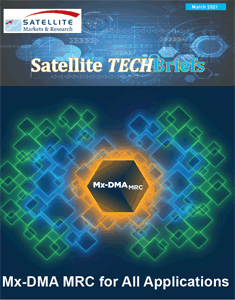Interview with Bart Van Poucke, Vice-President of Product Management, ST Engineering iDirect
Sint-Niklaas, Belgium, March 24, 2021--To explain the features and benefits of ST Engineering iDirect's newly-launched Mx-DMA Multi-Resolution Coding (MRC technology, Satellite Executive Briefing spoke with Bart Van Poucke, Vice-President of Product Management, ST Engineering iDirect. Excerpts of the interview follows:
 You have recently built upon your award-winning Mx-DMA® HRC technology with Mx-DMA MRC. What are the key features of MRC technology and what benefits would these provide your current and potential customers?
You have recently built upon your award-winning Mx-DMA® HRC technology with Mx-DMA MRC. What are the key features of MRC technology and what benefits would these provide your current and potential customers?
The successful introduction of Mx-DMA in 2014 enabled us to answer the MF-TDMA versus SCPC dilemma that many of our customers faced, and this was a milestone for the market. Now, with the added dimensions and scalability of MRC we are unlocking tremendous flexibility and scale so our customers can deliver a broader range of service levels at a lower cost structure without compromise.
The introduction of Mx-DMA MRC answers the market’s call for unprecedented service agility and extends the availability of Mx-DMA to very large networks, expanding the applicability and use of the technology to include a full spectrum of use cases.
Mx-DMA scales in MHz independent of the number of terminals so customers can be served with a single return link for the majority of their use cases, minimizing operational complexity and maximizing statistic multiplexing. Mx-DMA MRC delivers these benefits by maintaining the industry-leading spectral efficiency of Mx-DMA HRC while drastically improving the agility, scalability and fill efficiency. Designing an Mx-DMA MRC link does not require precise knowledge of the
traffic and terminal mix as the link self-optimizes in real time. Moreover, the high efficiency enables bandwidth savings, higher throughput, better network availability and substantial terminal cost savings.
What impact will Mx-DMA MRC technology have on overall Quality of Experience and its ability to serve many different markets and applications?
applications?
Through Mx-DMA MRC, customers can experience SCPC-like performance at very high throughput. For example, if you are uploading picture to Facebook, this won’t result in a big impact on the capacity requirement because MRC’s agility means that a wide carrier would only be assigned when needed and can then shift back to smaller, more agile carriers. Mx-DMA functionality uses real-time demand, link condition reports, optimization performance metrics and QoS profiles to maintain optimal bandwidth utilization at all times.
What markets and applications will Mx-DMA MRC serve?
Service providers can now cover a myriad of use cases in a single return link, from cruise ships and large enterprise customers to SCADA and broadband access, sharing satellite capacity more efficiently over a group of satellite terminals and applications achieving the lowest Total Cost of Ownership (TCO).
Succesful busines models are based on fitting smaller customers with high value customers where the smaller cutomers are not burdening the high value customers. Both networks have very different service requirements, and very different link budgets. Before introduction of Mx-DMA MRC, given the requirements of both services, Mx-DMA HRC for mobile backhaul and MF-TDMA for enterprise were the designated return technologies and would operate in separate static return capacity. Mx-DMA MRC is suited to both types of services, allowing both services to share one chunk of return capacity, improving efficiency and statistical multiplexing.
 |
| To read or download a pdf of the TECHBrief report on MX-DMA MRC sponsored by ST Engineering iDirect click here. |
How has the initial reaction been to MRC technology from your customers? Can you share some results of trials or beta tests that you have done or initial implementation of the technology?
Initial reaction to Mx-DMA MRC has been extremely positive and we have had great feedback from the market already in terms of results. One of our earliest adopters, Ningbo BIRDSAT, a Chinese service provider that serves coastal fishing vessels, has told us that they have noted a significant increase in bandwidth efficiency. In turn, this has helped to decrease the cost per satellite transponder, and the service quality has also been further improved enabling it to provide even better services to its customers. The return channel efficiency is superior and there is no packet loss. It has also allowed them to be more flexible in their service offering and to prioritize different services for different users. They are already planning to deploy new satellite networks in the coming months that are based on Mx-DMA MRC technology.
How integral is Research and Development (R&D) to ST Engineering iDirect and the development of Mx-DMA MRC?
Our R&D team is integral to our progress and the instigator for our innovations. We are an R&D driven company and innovation has always been in our DNA. With Mx-DMA MRC, we have built upon previous innovation and we’ve also drawn upon our experiences with our large installed base and large networks. Our previous work constantly informs us on our future work. With MRC we quite literally took a big leap forward. We took the best of what we had in Mx-DMA and then added a further dimension pushing the limits of efficiency in a shared bandwidth network yet again! I think it’s important to note that, as a forward-thinking team we are fully aware that the focus of innovation varies over time. Things change. But it’s very important that we employ cross-layer thinking in what we do which will lay the foundation for future innovations in new ground capabilities that are needed to keep pace with the developments in New Space across our industry.





